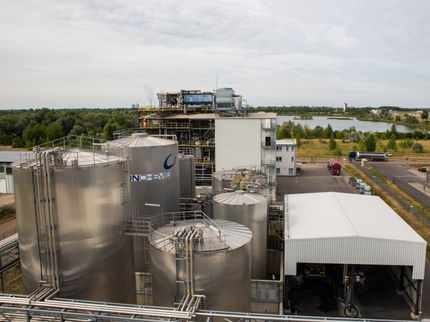New procedure for better thermoplastics
New insights thanks to nano imaging and spectroscopy at the IRIS beamline of BESSY II
Bio-based thermoplastics are produced from renewable organic materials and can be recycled after use. Their resilience can be improved by blending bio-based thermoplastics with other thermoplastics. However, the interface between the materials in these blends sometimes requires enhancement to achieve optimal properties. A team from the Eindhoven University of Technology in the Netherlands has now investigated at BESSY II how a new process enables thermoplastic blends with a high interfacial strength to be made from two base materials: Images taken at the new nano station of the IRIS beamline showed that nanocrystalline layers form during the process, which increase material performance.
Bio-based thermoplastics are considered environmentally friendly, as they are sourced from non-petroleum-based raw materials and can be recycled just like standard thermoplastics. A thermoplastic base material is Polylactic acid (PLA), which can be produced from sugar cane or corn. Researchers around the world are working to optimise the properties of PLA-based plastics, for example by mixing them with other thermoplastic base materials. However, this is a real challenge.
A new process for better blends
Now, a team from the TU Eindhoven led by Prof. Ruth Cardinaels is showing how PLA can be successfully mixed with another thermoplastic. They developed a process in which certain PLA-based copolymers (e.g. SAD) are formed during production, which facilitate the mixing of the two raw materials by forming particularly stable (stereo)-crystalline layers at the interfaces between the different polymer phases (ICIC strategy).
Insights at the IRIS-Beamline
At BESSY II, they have now discovered which processes ensure that the mechanical properties of the mixed thermoplastic are significantly better. To do so, they examined pure 50% blends of the thermoplastics PLA and polyvinylidene fluoride (PVDF) as well as samples with the PLA-based copolymers at the IRIS beamline of BESSY II.
Stereocomplex crystals at the interfaces
Using infrared spectroscopy on the IRIS beamline, PhD student Hamid Ahmadi was able to demonstrate the formation of the PLA-based copolymer SAD. Further X-ray measurements showed how the formation of SAD affects the crystallisation behaviour. The new nano imaging and spectroscopy capabilities at the IRIS beamline allow for advanced chemical visualization and identification from sample areas as small as 30 nm. This precision was crucial in determining that the stereocomplex crystals are exclusively located at the interface. Infrared nanoscopy images showed a 200–300 nm thick layer of stereocomplex crystals at the interfaces.
Reason for more stability
The formation of stereocomplex crystals at the interfaces increases the stability and crystallisation temperature. Nucleation at the interface accelerates the overall crystallisation process within the PLLA/PVDF blend. In addition, the interfacial crystalline layer improves the transfer of mechanical stresses between the phases and thus the tensile properties; the elongation at break even increases by up to 250 %.
“By elucidating the location and distribution of the crystalline layer in our samples, we could understand the procedure of mixing much better”, Hamid Ahmadi says. “By developing a new strategy we have cleared a path for the development of high-performance polymer blends”, Ruth Cardinaels adds.
Original publication
Hamid Ahmadi, Paul M. H. van Heugten, Alexander Veber, Ljiljana Puskar, Patrick D. Anderson, Ruth Cardinaels; "Toughening Immiscible Polymer Blends: The Role of Interface-Crystallization-Induced Compatibilization Explored Through Nanoscale Visualization"; ACS Applied Materials & Interfaces, Volume 16, 2024-10-16
Other news from the department science
Most read news
More news from our other portals
See the theme worlds for related content
Topic World Spectroscopy
Investigation with spectroscopy gives us unique insights into the composition and structure of materials. From UV-Vis spectroscopy to infrared and Raman spectroscopy to fluorescence and atomic absorption spectroscopy, spectroscopy offers us a wide range of analytical techniques to precisely characterize substances. Immerse yourself in the fascinating world of spectroscopy!

Topic World Spectroscopy
Investigation with spectroscopy gives us unique insights into the composition and structure of materials. From UV-Vis spectroscopy to infrared and Raman spectroscopy to fluorescence and atomic absorption spectroscopy, spectroscopy offers us a wide range of analytical techniques to precisely characterize substances. Immerse yourself in the fascinating world of spectroscopy!






























































